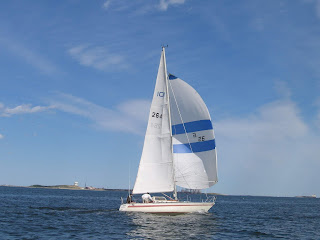A topic I study with some care. Some links to vlogs and blogs will follow.
To start, let's consider a factor that is seldom discussed:
"Is cruising more expensive than living ashore?" Is cruising more expensive than...? The old "compared to what" discussion. My study and personal experience is that it is not more expensive to live aboard and cruise than live ashore and do whatever it is shore dwellers do. Of course, it can be. That's because the cruiser chooses to make it so. I suppose one choose to live on less and make cruising less expensive than living ashore. "Compared to what" is a function of choices.
Looking at where I live, a moderate house costs about $400K and a typical household spends from $6 to $10K a month to live. That's including mortgage, maintenance, taxes, utilities, food, entertainment, vehicles, insurance and so on. This is a nice place to live with plenty to do and work if you want it. A nice cruising boat is about $100K and cruising costs run around $3K a month. Is cruising expensive? You decide.
As cruising sailors, we'd probably live the same way we do ashore and spend less than living ashore. We'd live in an inexpensive cruising area, exploring ashore on foot. We already do that where we live and also have higher expenses.
As a charter boat skipper, I see guests spend up to ten grand for a week of sailing. Hardly the typical cruising family life style. Probably why the image of cruising as expensive is so skewed. Likewise, I meet cruisers who are tied to a dock performing repairs on their complicated yachts. Simplify?
My parents cruised almost all of their lives, more after the kids moved out! They said the cost of living afloat and living ashore were about the same. It is just the way one lives that affects the cost of living. They were teachers.
Suggestion for managing costs: start with a well prepared yacht that is simple in its maintenance requirements and then maintain the yacht yourself. Simplify, simplify, simplify.
https://sailingsoulianis.com/
Maybe the most comprehensive contemporary blog on the subject.
These YouTube videos contain some useful information about the cost of cruising:
Sailing Magic Carpet:
https://www.youtube.com/watch?v=RKL-gO9946c&t=173s
Sailing Doodles:
https://www.youtube.com/watch?v=Qkdt7zx_bS4&t=30s
Ryan and Sophie Sailing (three parts examine three boats):
https://www.youtube.com/watch?v=UM5iRHDEXPM and
https://www.youtube.com/watch?v=vMGW3XEImjI&t=745s and
https://www.youtube.com/watch?v=ZxJQIiV1nnI
Sailing Kittiwake:
https://www.youtube.com/watch?v=r9DjSOLCxTM&t=169s
Sailing Balachandra:
https://www.youtube.com/watch?v=ZbD_hPe_biE
Some blogs I have found useful are:
https://www.youtube.com/watch?v=E82-doOJezU
http://svbebe.blogspot.com/p/costs.html
http://thegiddyupplan.blogspot.com/2011/04/cost-of-cruising.html
http://lifeafloatarchives.blogspot.com/2012/04/cost-of-living-afloat.html
http://www.mid-lifecruising.com/p/expenses.html
More to follow...
And then, how different is cruising from life ashore is nicely described by the Magic Carpet couple
https://www.youtube.com/watch?v=orTfSy7lm24
















